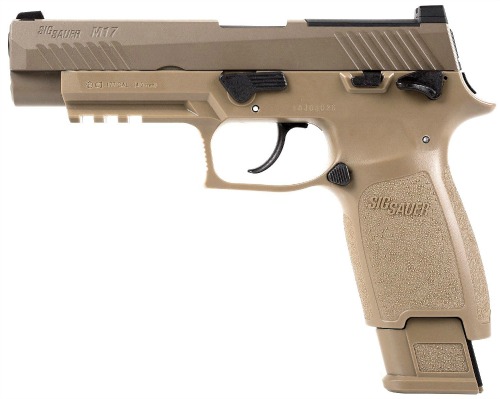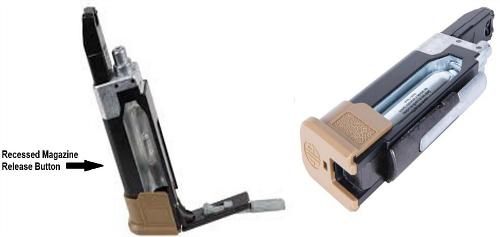|
SIG SAUER M17 ASP Air Pistol  If you check out the SIG catalog, you will find the P320 ASP air pistol, which was designed as a training tool for those agencies that have purchased the SIG-SAUER P320 9mm Luger service pistol. It was shortly after the introduction of that air pistol that the US Army announced that a slightly modified SIG P320 won the competition to become the new US Army sidearm, designated as the M17. It was only logical that SIG produce a replica air pistol of the M17 for training purposes. At this point, we should point out that the M17 ASP is NOT the same as the P320 ASP air pistol. They are two distinct and separate clones of two distinct and separate firearms. For starters, the P320 ASP had a 30-round magazine that had occasional issues in feeding. The newly designed 20-round magazine (Rapid Pellet Magazine) of the M17 ASP does not have those problems and consistently feeds smoothly. The M17 ASP can be field stripped (the P320 ASP could not), not only simulating its centerfire parent, but also making it easy to remove a jammed pellet, should that occur. This pistol has the same look and feel as the polymer frame of the M17 centerfire pistol, including a metal slide with a blow-back action. The physical measurements of the M17 ASP are virtually identical to its centerfire counterpart. Although the M17 centerfire pistol is lighter than the M17 ASP when empty (29.4 oz vs 34.4 oz), they are comparable when the M17 is loaded. All things considered, the M17 ASP is as perfect a functioning clone as is possible. When handling the ASP, it is very easy to forget that you have an air pistol in your hands and not the real thing. However, as good as this gun looks and handles, the major question is, how does it shoot? In order to be an effective training piece the gun must cycle through the 20 round magazine without jamming and it must be accurate. Preparing the M17 for shooting is incredibly easy. The quick release magazine button drops out both the 20 round magazine and the housing for the 12 gram CO2 cylinder that powers the pistol.  Loading a CO2 cylinder is a snap. Simply pull the cam lever down, drop in a cylinder and close the cam lever. The cam lever loading system is unique and patented by SIG. To load pellets, simply depress the recessed button on the front of the housing (not visible in the picture) and the magazine drops out for loading. When finished, insert the magazine back into the housing and replace the housing into the grip of the M17, as you would do in loading any semi-automatic pistol. Make sure that the ambidextrous thumb safety is on before inserting the magazine/CO2 housing unit. Now it is time to get serious and determine whether this piece will deliver the advertised 430 f.p.s. velocity and record its accuracy. Jim took the gun outside and set up our SIG QUAD shooting gallery at 15 yards and prepared our Caldwell G2 Chronograph to record the average velocity of the pellets. We used Sig SAUER 5.25 grain match ballistic alloy pellets for our tests. We are situated on a high mesa in New Mexico at an elevation of 4,835 ft above sea level. We performed our tests when the air temperatures were averaging 75 degrees F. The velocities varied from 365 f.p.s. To 380 f.p.s., with the overall average being 375 f.p.s. We were never able to achieve the 430 f.p.s. listed in the specs for the M17. The M17 did not have enough power to completely knock back the falling targets, so a reset was not required. We used up all of the target stickers for the gallery and more than half of the pellets that SIG supplied to us. Not only was the M17 very accurate, despite a heavy 6.5 pound trigger pull, it was also a lot of fun to shoot. Features and Specifications
Mr. Joseph Huston, VP and General Manager of the SIG Air division, can be rightly proud of this gun. It truly does incorporate all of the best features of every SIG air pistol into a single unit. With an MSRP of $139.99 it is well worth the price, either as a training tool for military and/or law enforcement personnel, or just for fun. It really is a lot of fun to shoot this pistol. Make sure you have a lot of pellets and CO2 cartridges after you set up your targets, you'll need them. |